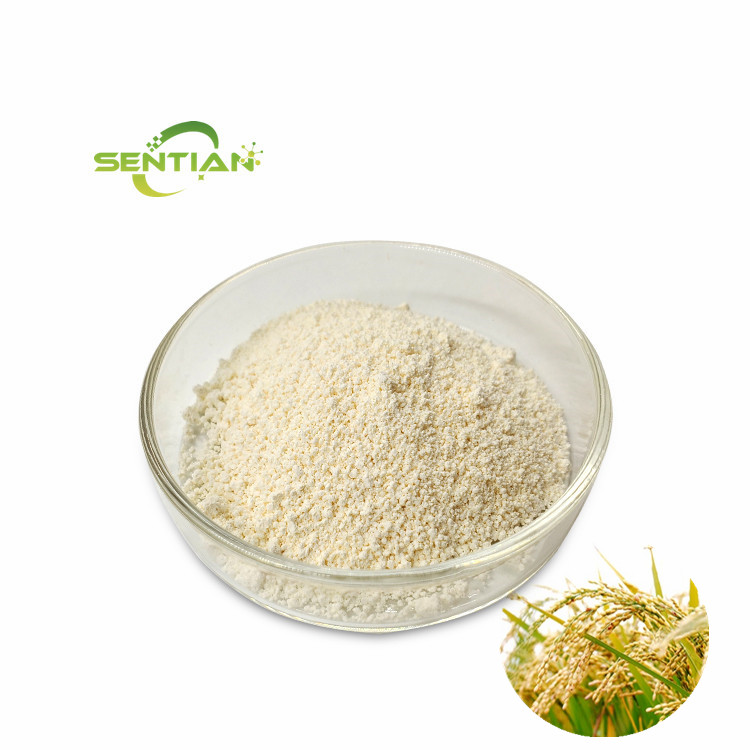Ferulic acid is a type of organic compound that is commonly found in the cell walls of plants. It is a powerful antioxidant that helps to protect cells from damage caused by free radicals.
Ferulic acid is often used in skincare products for its anti-aging and skin brightening properties. Ferulic acid is also believed to have anti-inflammatory and anti-cancer properties. Additionally, ferulic acid is found in certain foods such as whole grains, fruits, and vegetables.
 The Funtion of Ferulic Acid
The Funtion of Ferulic Acid
1. Antioxidant properties: Ferulic acid is a potent antioxidant that helps to neutralize free radicals in the body, which can cause damage to cells and contribute to aging and disease.
2. Anti-inflammatory effects: Ferulic acid has been shown to have anti-inflammatory properties, which can help reduce inflammation in the body and alleviate symptoms of conditions such as arthritis and inflammatory skin conditions.
4. Anti-cancer properties: Some studies suggest that ferulic acid may have anti-cancer effects, as it has been shown to inhibit the growth of cancer cells and induce apoptosis (cell death) in certain types of cancer.
5. Cardiovascular health: Ferulic acid may help to improve cardiovascular health by reducing inflammation, lowering cholesterol levels, and protecting against oxidative stress, which can contribute to heart disease.
Application of Ferulic Acid
Application of ferulic acid in the medical field
It is now known that ferulic acid and its derivatives have the effects of anti-oxidation, scavenging free radicals, anti-inflammatory, analgesic, anti-ultraviolet radiation and improving human immunity, and drugs with corresponding effects have also been gradually developed. For example: Sodium ferulate injection is used for the treatment of ischemic cardiovascular and cerebrovascular diseases, and ferulic acid piperazine tablets are suitable for the auxiliary treatment of various glomerular diseases accompanied by microscopic hematuria and hypercoagulable state. There are also some Chinese patent medicine preparations containing ferulic acid.
Application of ferulic acid in the food industry
At present, Japan has approved the use of ferulic acid as a food antioxidant, and the United States and some European countries have also begun to use some substances with high ferulic acid content as antioxidants to preserve food. In my country, ferulic acid is widely used in the food industry as a food additive.
Used as an antioxidant
Jiang Ruiping et al. added 75 mg/kg ferulic acid and 500 mg/kg sodium isoVc compound additives to the sausage formula, which can effectively reduce the residual nitrite, improve the antioxidant performance of the sausage, and maintain the original sensory quality of the sausage.
Used as a food cross-linking agent
Ferulic acid is not only an
Antioxidant Powder, but also can be added to food to cross-link food, thus improving the application value of food. Ferulic acid can cross-link proteins, polysaccharides, proteins and polysaccharides, and polysaccharides and polysaccharides, and it is cheap, safe and non-toxic. Chen Dajia et al. used ferulic acid to modify collagen-chitosan composite membranes and found that ferulic acid can improve the performance of composite membranes, such as increasing the mechanical properties of composite membranes and reducing water vapor permeability, which indicates that ferulic acid can increase the cross-linking between molecules of collagen-chitosan composite membranes.film.
Application of ferulic acid in the cosmetics industry
In addition to
ferulic acid whitening, ferulic acid is favored by the cosmetics industry because it has strong antioxidant and oxygen free radical scavenging effects, and inhibits tyrosinase activity, which can delay skin aging and whiten the skin. In addition, ferulic acid has sun protection ability and has good ultraviolet absorption near 290-330 nm, which can prevent and reduce the damage of ultraviolet rays of this wavelength to the skin.
American SkinCeuticals skin care products contain natural 15% L-Vc, 1% Ve and specially incorporated ferulic acid ingredients, which enhance the unique antioxidant capacity of Vc+Ve.
In summary, ferulic acid exists in many plants and has a wide range of biological activities. It has been used in the pharmaceutical, food, and cosmetics industries and has achieved good results. Structural transformation and modification of ferulic acid may develop ferulic acid derivatives with stronger activity and less toxic side effects. These studies will undoubtedly improve the application value of related plants.
The COA of Ferulic acid








